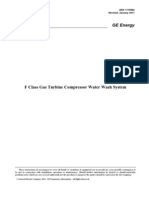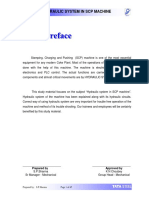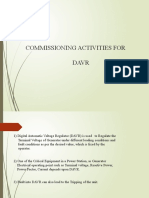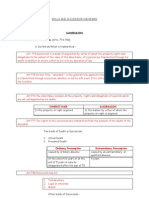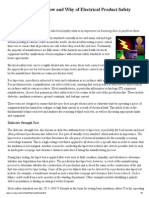Untitled
Untitled
Uploaded by
PMG Bhuswal ProjectCopyright:
Available Formats
Untitled
Untitled
Uploaded by
PMG Bhuswal ProjectOriginal Description:
Copyright
Available Formats
Share this document
Did you find this document useful?
Is this content inappropriate?
Copyright:
Available Formats
Untitled
Untitled
Uploaded by
PMG Bhuswal ProjectCopyright:
Available Formats
‐‐‐‐‐‐‐‐‐‐‐‐‐‐‐‐‐‐‐‐‐‐‐‐‐‐‐‐‐‐‐‐‐‐‐‐‐‐‐‐‐‐‐‐‐‐‐‐‐‐‐‐‐‐‐‐‐‐‐‐‐‐‐‐‐‐‐‐‐‐‐‐‐‐‐‐‐‐‐‐‐‐‐‐‐‐‐‐‐‐‐‐‐‐‐‐‐‐‐‐
4 18000 F4 417‐‐‐‐REV00
1.0 Introduction
All large generators require auxiliary systems to operate/run smoothly. Auxiliary systems such as
sealing oil for sealing hydrogen gas in the generator casing, Hydrogen gas for hydrogen cooled
rotors, demineralized water for stator winding cooling etc ensure efficient, reliable and safe
operation of the generator. Not all generators require all these systems & the requirement depends
on the size & nature of the machine. The auxiliary systems which are applicable for 660 MW
THDF generators are:-
Single flow seal oil system
Primary/stator water system
Generator gas system
Hydrogen filling system
Gas drying system
Fire protection and depressurization system
Waste Gas system
Generator instrumentation
Generator protection circuit
Besides the auxiliary systems DC starter panels are also critical controls required in operation
during pump motor or power supply failure. The panels are
Starter panel for DC Seal oil Pump
Starter panel for DC Emergency lube oil Pump
2.0 Single flow seal oil system
REFERENCE P&ID: 1-149-00-01234
The rotor shaft ends of hydrogen cooled generators are supplied with pressurized seal oil to
prevent hydrogen losses via the seals and the ingress of air into the generator. This seal oil is fed
to the shaft seal on both the exciter (EE) and the turbine end (TE).The supplied seal oil is then
drained in approx. equal quantities to the hydrogen side and the air side through the annular gaps
between the shaft and the seal rings.
Three seal oil pumps (two pumps: MKW11AP001 & MKW12AP001 with three phase AC
motors and typically one pump, MKW13AP001 with a DC motor) are provided for the seal oil
system. These pumps draw oil from the vacuum tank and the seal oil storage tank. Downstream
of each AC pump pressure transmitter MKW11CP001/ MKW12CP001 and downstream of DC
pump three pressure transmitters MKW13CP001/002/003 are installed for measuring the actual
pressure signal. These transmitters generate the signal for the changeover between the two AC
pumps when seal oil pressure drops below a certain minimum value and for emergency start-up
of DC pump when neither of the two AC pumps builds up the desired pressure in the system.
Both the AC pumps are connected to different busbars to achieve successful changeover to the
pump connected to healthy busbar during under-voltage condition.
CONTROL AND INSTRUMENTATION ENGINEERING
BHEL, HARIDWAR. Page 2
‐‐‐‐‐‐‐‐‐‐‐‐‐‐‐‐‐‐‐‐‐‐‐‐‐‐‐‐‐‐‐‐‐‐‐‐‐‐‐‐‐‐‐‐‐‐‐‐‐‐‐‐‐‐‐‐‐‐‐‐‐‐‐‐‐‐‐‐‐‐‐‐‐‐‐‐‐‐‐‐‐‐‐‐‐‐‐‐‐‐‐‐‐‐‐‐‐‐‐‐ 4 18000 F4 417‐‐‐‐REV00
The seal oil drained from the hydrogen side of the shaft seals is first collected in the generator
pre-chambers (EE & TE) from where it flows to the intermediate oil tank. Each pre-chamber is
fitted with a level probe (MKA06/07CL001) which triggers a warning if the oil level exceed a
specified maximum limit. Another level probe (MKW06CL001) installed in the intermediate oil
tank triggers a warning if the oil level drops below a specified minimum value. Level probes are
also installed in the vacuum tank, one (MKW10CL001) for maximum limit control and the other
two (MKW10CL002 & MKW10CL003) for minimum limit control. The level sensors for
minimum limit control are used for the dry run protection of both the AC seal oil pumps. A level
sensor (MKW01CL001) installed in the seal oil storage tank generates a warning if the level is
too low.
The DC operated emergency pump can only be switched off manually. A warning is generated as
soon as the DC pump is activated. After a continuous operation of DC pump for 30 minutes the
generator is depressurized by opening the fire protection valves and the turbine trip is activated to
protect the turbine-generator set.
All of the above controls are realized in BHEL DCS located in the control equipment room.
3.0 Primary /Stator water system
REFERENCE P&ID: 0-153-00-01137
The primary water system is designed to supply primary water to the hollow stainless steel (660
MW) conductors with the primary water coolant.
For the circulation of primary water through the stainless nonmagnetic steel alloy stator
conductors two 100% AC three phase driven water pumps: MKF11AP001 &MKF12AP001 are
provided. Downstream of each AC pump pressure transmitter MKF11CP001/ MKF12CP001 are
installed for measuring the actual pressure signal and generate the signals for the changeover
between the two AC pumps when pump discharge pressure drops below a certain minimum value.
Level in the primary water tank is measured using level transmitter and an alarm is initiated when
the level falls below a minimum set value.
The small amount of hydrogen leak in the primary water system is vented by the expansion and
storage tank with degassing arrangements (water filled U loop).
A conductivity transmitter MKF29CQ011 installed after the primary water pumps trigger alarm
when the conductivity limit is above a certain minimum value.
A pressure transmitter (MKF41CP001) located in the upstream of stator winding initiates alarm
when the pressure is more than a maximum tolerable value. In order to ensure smooth flow of
water through the hollow stator bars, differential pressure transmitter (MKA20CP021) is installed
across the inlet and the outlet of the stator bars. A warning is generated when the differential
pressure is more than a certain set value.
The primary water filters are monitored for choking and warning is generated. Transmitter
MKF27CP021/ MKF28CP021 is mounted on each PW filter for differential pressure
measurement.
CONTROL AND INSTRUMENTATION ENGINEERING
BHEL, HARIDWAR. Page 3
‐‐‐‐‐‐‐‐‐‐‐‐‐‐‐‐‐‐‐‐‐‐‐‐‐‐‐‐‐‐‐‐‐‐‐‐‐‐‐‐‐‐‐‐‐‐‐‐‐‐‐‐‐‐‐‐‐‐‐‐‐‐‐‐‐‐‐‐‐‐‐‐‐‐‐‐‐‐‐‐‐‐‐‐‐‐‐‐‐‐‐‐‐‐‐‐‐‐‐‐ 4 18000 F4 417‐‐‐‐REV00
All of the above controls are realized in BHEL DCS located in the control equipment room.
4.0 Generator gas system
REFERENCE P&ID: 0-149-00-01365
The gas system comprises of the following main sub systems:-
- Generator hydrogen filling system.
- Gas drying system.
- Fire protection valves & depressurization system
- Waste Gas system
4.1 Generator hydrogen filling system:-
The generator is filled with hydrogen (H2) gas used as coolant and for purging the generator with
inert gas (CO2) during hydrogen charging. The hydrogen pressure at the manifold and in the
generator is measured by explosion proof transmitters (MKG10CP001 & MKG18CP001/2/3). An
alarm is initiated when the pressure at the manifold drops below a certain minimum value. The
pressure transmitters MKG18CP001/2/3 measuring the generator casing pressure are also
connected in a differential pressure configuration to the seal oil pressure and this differential
pressure signal is used in the protection circuit.
Purity of Hydrogen is measured by gas analyzers. A three range gas analyser is used to measure
H2 or CO2 purity. Alarm is initiated when purity falls below 95% Hydrogen in Air.
During carbon dioxide (CO2) filling, the CO2 is passed through parallel arrangements of CO2
flash evaporators. A warning is generated for high CO2 evaporator heater temperature.
4.2 Generator gas drying system:-
In order to maintain the dew point within the threshold limit it is important to keep the
hydrogen gas dry. Refrigeration type gas driers MKG69BT001 and MKG69BT011 are used.
Most Hydrogen from the generator is first passed through a gas to gas heat exchanger. The
hot moist gas on the primary side is cooled in advance through the dried and cold gas on the
secondary side. This heat exchanger is shell and tube type with cold gas passing through the
tubes.
After the pre-cooling the H2 gas passes through the evaporator, which is Freon to gas heat
exchanger. In this way cooling takes place at constant pressure dew point up to 2-3 °C. The
evaporator is again a shell and tube type heat exchanger in which refrigerant from condenser
passes through copper tubes and pre-cooled H2 gas surrounding the tubes. This way heat
from H2 gas is taken away by liquid circulating through tubes. The H2 gas sheds excess
moisture, which is collected in the condensate chamber.
CONTROL AND INSTRUMENTATION ENGINEERING
BHEL, HARIDWAR. Page 4
‐‐‐‐‐‐‐‐‐‐‐‐‐‐‐‐‐‐‐‐‐‐‐‐‐‐‐‐‐‐‐‐‐‐‐‐‐‐‐‐‐‐‐‐‐‐‐‐‐‐‐‐‐‐‐‐‐‐‐‐‐‐‐‐‐‐‐‐‐‐‐‐‐‐‐‐‐‐‐‐‐‐‐‐‐‐‐‐‐‐‐‐‐‐‐‐‐‐‐‐ 4 18000 F4 417‐‐‐‐REV00
The cold dry H2 gas is passed through pre-cooler where it is heated to about 8-10° C below
the inlet gas temperature and is finally fed to the generator.
The condensate chamber is provided with a sight glass. The water from the condensate
chamber shall be manually drained.
The gaseous Freon leaving evaporator is compressed by a hermetically sealed compressor
and cooled in the condenser. The compressor, therefore, provides the required cooling power.
Changeover from one refrigerator drier to another is manual.
4.3 Fire protection valves & Depressurization:-
In case of H2 cooled Generator, it is very important to de-pressurize the Generator in event of
emergency for safety of power plant. It shall be ensured that H2 gas can be vented to
atmosphere at any time by remote operation. Same is achieved by operation of four fire
protections solenoid valves manually or automatically. To avoid ingress of air into the
Generator, these valves are closed automatically, when casing pressure reaches to minimum
set value. To achieve de-pressurization quickly, stand by Generator exhaust fan is also
switched ON during this operation. On initiation of de-pressurization, turbine trip is activated
to protect Turbine- generator set.
The two pairs of valves MKG19AA025 & 035 and MAG19AA026 & 36 are connected to
separate 24VDC power supplies. These valves are open when de-energised (to make system
fail safe). Power supply for these Solenoid valves MKG19AA025 & 035 must be routed
separately from power supply of MAK19AA026 & 036 to ensure power supply for two
parallel fire protection valves in the event of malfunction
These valves are operated in following critical conditions only:-
1) Control during operation with DC seal oil pump:- If AC pumps are not available
and DCSOP is operating. After 30 minutes these valves are operated to bring
generator in safe state.
2) Both Generator Exhaust Fans failed:- If both exhaust fans failed and one seal oil
pump is working, a alarm is issued with a delay of 40 seconds. Command issued to
valves if same criterion stays for 60 minutes.
3) Emergency push button:- The pushbutton MKG00GS001 ( 3 NC contacts) is
connected to 24VDC supply and will be read on three channels. Valves will operate
by 2v3 voting if Generator casing pressure is greater than minimum set value.
4) Differential pressure between H2 and seal oil: - Pressure of H2 gas in Generator
casing and pressure of Seal oil is monitored in a redundant configuration. Differential
pressure is formed in 2v3 circuit. Alarm is issued if the pressure difference drops to
minimum value and DC Seal oil pump is switched ON. If pressure difference drops to
further minimum value, then these valves are operated.
CONTROL AND INSTRUMENTATION ENGINEERING
BHEL, HARIDWAR. Page 5
‐‐‐‐‐‐‐‐‐‐‐‐‐‐‐‐‐‐‐‐‐‐‐‐‐‐‐‐‐‐‐‐‐‐‐‐‐‐‐‐‐‐‐‐‐‐‐‐‐‐‐‐‐‐‐‐‐‐‐‐‐‐‐‐‐‐‐‐‐‐‐‐‐‐‐‐‐‐‐‐‐‐‐‐‐‐‐‐‐‐‐‐‐‐‐‐‐‐‐‐ 4 18000 F4 417‐‐‐‐REV00
5) Generator Casing pressure protection: - Generator casing pressure is monitored in
2v3 configuration. In the event that the casing pressure drops to the trip level (due to a
major leakage), these valves are operated.
Pushbuttons are provided in the control room for opening the fire protection valves.
Note:- These valves should not be used to reduce the casing H2 gas pressure in normal
operation
Operation of Fire protection valves is realized in Siemens SPPA T3000 located in the control
equipment room.
4.4 Waste Gas system: -
REFERENCE P&ID: 2-149-00-01191
During the generator frame filling and emptying procedures, the existing air, inert gas and
hydrogen (H2), as well as mixtures of these gases, must also be discharged via a defined path.
These gases are removed in a defined process through waste gas lines. These waste gas lines
exhaust above the roof in order to ensure safe discharge of the gas mixtures to atmosphere.
The waste gas system also includes two redundant extraction fans which generate a slight partial
vacuum. The generator bearing spaces (TE&EE), the sealing oil supply tank, the primary water
tank and gas dryer are connected to the extraction fan/bearing exhaust fan. Three number
pressure transmitters are provided before the exhaust fan. When the active exhauster is no longer
able to maintain the required vacuum (MKQ81CP001/2/3), the standby exhauster starts
automatically. The other exhauster is shut down when the vacuum is back.
All of the above controls are realized in BHEL DCS (except Fire protection valves) located in the
control equipment room.
5.0 Generator Instrumentation
REFERENCE P&ID: 0-139-00-01481
The Generator instrumentation provides measurements at various generator points such as the
generator stator slot, generator stator core, hot gas temperature measurement etc. Resistance
temperature detectors (MKA20CT*) & (MKA35*) are provided to obtain data on the stator slot
temperature and stator core temperature during operation. Impermissible deviations from the
normal values indicate a fault in the core laminations. Inside the generator’s hot gas chambers are
the temperature sensors which measure the hot gas temperature, while the cold gas temperature is
measured downstream of the coolers. If the measured temperature values are outside the
tolerance bands, alarm is generated, indicating a fault in the cooling system.
All of the above measurements are realized in Siemens BHEL DCS located in the control
equipment room.
CONTROL AND INSTRUMENTATION ENGINEERING
BHEL, HARIDWAR. Page 6
‐‐‐‐‐‐‐‐‐‐‐‐‐‐‐‐‐‐‐‐‐‐‐‐‐‐‐‐‐‐‐‐‐‐‐‐‐‐‐‐‐‐‐‐‐‐‐‐‐‐‐‐‐‐‐‐‐‐‐‐‐‐‐‐‐‐‐‐‐‐‐‐‐‐‐‐‐‐‐‐‐‐‐‐‐‐‐‐‐‐‐‐‐‐‐‐‐‐‐‐ 4 18000 F4 417‐‐‐‐REV00
6.0 Generator Protection
The trip signals from various protection criteria as listed below are gated in OR logic and the trip
over the turbine trip system is initiated. Warnings and a group alarm from the generator are read
in and displayed. The trip signal is read in by two channels in order to trip the turbine.
All the protection controls as given below are realized in BHEL DCS/ Siemens SPPA T3000
located in the control equipment room.
1. Liquid level in the terminal box.
Command is issued to trip the generator when the oil level in the generator terminal box is
above the set limit value. Three numbers of level switch MKA16CL111, 112, and 113 are used
for signal measurement in 2V3 configuration.
2. Absolute cold gas protection cooler A/B/C/D
Command is issued to trip the generator when the cold gas temperature generator terminal box is
above the set limit value. Three numbers of temperature measurements after each cooler set:
MKA71CT011/12/13 after coolers A/B & MKA71CT031/32/33 after cooler C/D are used for
signal measurement in 2V3 configuration.
3. Temperature generator bearings
The temperature of every generator bearing is monitored via triplex thermocouples
MKD11/12/CT013/17 & MKD15CT013/17. When critical values are reached, pre-trip alarm at
high is issued and trip is initiated at very high set point.
4. Bearing casing vibration
Considerable importance is attached to vibration monitoring and protection measures for the
steam turbine generator unit. The vibration data supply important information regarding the
mechanical condition of the operating turbine unit. This protection is realized in two out of two
configurations. The signal generated by the vibration probes (MKD11/MKD12/MKD15CY021
& CY022) are displayed at the operator station of the control system for operator information and
recorded for long term storage. Pre-trip alarm is initiated to inform the operator in and Trip is
initiated automatically when the vibration exceeds the very high critical limit.
5. Temperature downstream of PW cooler
Temperature downstream of primary water cooler is measured using three numbers of RTDs
MKF29CT011/12/13.The protection circuit is realized in 2V3 configuration. When the
temperature exceeds the limit value pre-trip alarm is initiated to inform the operator and Trip is
initiated automatically when the value exceeds the very high critical limit.
6. Flow rate downstream of stator winding
This protection is realized in 2V3 configurations. The flow is measured using three numbers of
flow transducers MKF41CF011A, MKF41CF011B and MKF1141CF012. Pre-trip alarm is
CONTROL AND INSTRUMENTATION ENGINEERING
BHEL, HARIDWAR. Page 7
‐‐‐‐‐‐‐‐‐‐‐‐‐‐‐‐‐‐‐‐‐‐‐‐‐‐‐‐‐‐‐‐‐‐‐‐‐‐‐‐‐‐‐‐‐‐‐‐‐‐‐‐‐‐‐‐‐‐‐‐‐‐‐‐‐‐‐‐‐‐‐‐‐‐‐‐‐‐‐‐‐‐‐‐‐‐‐‐‐‐‐‐‐‐‐‐‐‐‐‐ 4 18000 F4 417‐‐‐‐REV00
initiated to inform the operator and Trip is initiated automatically when the value exceeds the
very high critical limit.
7. Flow rate downstream of bushing
This protection is realized in 2V3 configurations. The flow is measured using three numbers of
flow transducers MKF51CF011/12/13, MKF51CF21/22/23 and MKF51CF031/32/33 in each
bushing. Pre-trip alarm is initiated to inform the operator and Trip is initiated automatically when
the value exceeds the very high critical limit.
8. Generator casing pressure
The generator casing pressure protection is realized in two out of three failsafe configuration.
The three explosion proof pressure transmitters MKG18CP001/002/003 generates continuous
signal of pressure value. When the pressure exceeds the low limit value pre-trip alarm is initiated
to inform the operator and Trip is initiated automatically when the value exceeds the very low
critical limit.
9. Differential pressure –Seal oil/H2 casing pressure.
This generator seal oil and casing pressure differential is generated in the DCS. The transmitters
MKW31CP051/52/53 and MKG18CP001/002/003 are used to derive the signal
MKW31CP901/902/ 903. When the differential pressure exceeds the low limit value pre-trip
alarm is initiated to inform the operator and Trip is initiated automatically when the value
exceeds the very low critical limit.
CONTROL AND INSTRUMENTATION ENGINEERING
BHEL, HARIDWAR. Page 8
You might also like
- Descritivo de Manutenção - Guindaste Appleton Marine - SWL 30 TonsNo ratings yetDescritivo de Manutenção - Guindaste Appleton Marine - SWL 30 Tons9 pages
- Illuminati Card Game - Steve Jackson - TextNo ratings yetIlluminati Card Game - Steve Jackson - Text343 pages
- Vapor Cycle Air Conditioning System TR-134 SM100% (1)Vapor Cycle Air Conditioning System TR-134 SM33 pages
- Terex Crane Owner'S Manual TXCR326/H/A: A/C & Oil Heat System100% (1)Terex Crane Owner'S Manual TXCR326/H/A: A/C & Oil Heat System52 pages
- Very GOOD Condition Monitoring Transformers100% (3)Very GOOD Condition Monitoring Transformers67 pages
- Tm2500+ Mobile Gas Turbine Package Including SCOPE OF SUPPLYNo ratings yetTm2500+ Mobile Gas Turbine Package Including SCOPE OF SUPPLY10 pages
- Bombardier Learjet-Hydraulics and Landing Gear100% (1)Bombardier Learjet-Hydraulics and Landing Gear23 pages
- Operation & Maintanance Manual For HVWS System100% (1)Operation & Maintanance Manual For HVWS System18 pages
- 1.1.1 Low Pressure Compressed Air System: 1.1.1.1 GeneralNo ratings yet1.1.1 Low Pressure Compressed Air System: 1.1.1.1 General3 pages
- Generator & Auxillaries (Stator Water, Seal Oil and Hydrogen Gas System)100% (4)Generator & Auxillaries (Stator Water, Seal Oil and Hydrogen Gas System)32 pages
- GE Energy LM2500+ G4 Operation and Maintenance Manual: Fuel System Description100% (1)GE Energy LM2500+ G4 Operation and Maintenance Manual: Fuel System Description4 pages
- Fisher Steam Turbines Application Guide August 2013100% (1)Fisher Steam Turbines Application Guide August 201311 pages
- TOM Training Centrifugal Compressors: IndexNo ratings yetTOM Training Centrifugal Compressors: Index8 pages
- Internship Report Kandhkot Gas Field: Submitted byNo ratings yetInternship Report Kandhkot Gas Field: Submitted by10 pages
- 1.5 S5 9012974 02 - 0 System DescriptionNo ratings yet1.5 S5 9012974 02 - 0 System Description12 pages
- Fluid Power & Tribology Section Refuelling Technology Division Bhabha Atomic Research Centre Trombay, Mumbai - 85No ratings yetFluid Power & Tribology Section Refuelling Technology Division Bhabha Atomic Research Centre Trombay, Mumbai - 8528 pages
- BMed Medical Air Systems Oil-Injected Screw HTM 60Hz Technical Datasheet EN 4233500085.00No ratings yetBMed Medical Air Systems Oil-Injected Screw HTM 60Hz Technical Datasheet EN 4233500085.0019 pages
- Ioties Document No:-Mccpl-Pctl-Acc-Doc-M-0001 - Rev. P3No ratings yetIoties Document No:-Mccpl-Pctl-Acc-Doc-M-0001 - Rev. P323 pages
- Installation and Operation Instructions For Custom Mark III CP Series Oil Fired UnitFrom EverandInstallation and Operation Instructions For Custom Mark III CP Series Oil Fired UnitNo ratings yet
- Troubleshooting Process Plant Control: A Practical Guide to Avoiding and Correcting MistakesFrom EverandTroubleshooting Process Plant Control: A Practical Guide to Avoiding and Correcting Mistakes1/5 (2)
- Contemporary Anaesthetic Equipments.: An Aid for Healthcare ProfessionalsFrom EverandContemporary Anaesthetic Equipments.: An Aid for Healthcare ProfessionalsNo ratings yet
- TGE 3668 - Rev-01 - Write-Up of Generator Primary Water SystemNo ratings yetTGE 3668 - Rev-01 - Write-Up of Generator Primary Water System11 pages
- RCD Presentation On MERC MYT Regulations, 2019No ratings yetRCD Presentation On MERC MYT Regulations, 201918 pages
- Bharati Krsna Tirthaji, V. S. Agrawala (Editor) - Vedic Mathematics - Sixteen Simple Mathematical Formulae From The Vedas-Motilal Books (1970)No ratings yetBharati Krsna Tirthaji, V. S. Agrawala (Editor) - Vedic Mathematics - Sixteen Simple Mathematical Formulae From The Vedas-Motilal Books (1970)424 pages
- MCQ On Power Systems 5eea6a0f39140f30f369e734 PDFNo ratings yetMCQ On Power Systems 5eea6a0f39140f30f369e734 PDF20 pages
- Field and Stator Ground Fault Protection Modules: Grid SolutionsNo ratings yetField and Stator Ground Fault Protection Modules: Grid Solutions64 pages
- INTCV385 - HV and MV Switchgear (CB, CT, CVT, DC and SA) Operaion, Maintenance - L2 - v1No ratings yetINTCV385 - HV and MV Switchgear (CB, CT, CVT, DC and SA) Operaion, Maintenance - L2 - v13 pages
- English Alphabets Reading Writing Worksheets PDFSevaNo ratings yetEnglish Alphabets Reading Writing Worksheets PDFSeva10 pages
- Zueblin Imagebrosch 2017 ENG ES STRAnetNo ratings yetZueblin Imagebrosch 2017 ENG ES STRAnet32 pages
- Mwandila v Phiri (Appeal 182 of 2013) 2022 ZMSC 47 (26 May 2022)No ratings yetMwandila v Phiri (Appeal 182 of 2013) 2022 ZMSC 47 (26 May 2022)45 pages
- Waste Management: Sama Azadi, Ayoub Karimi-JashniNo ratings yetWaste Management: Sama Azadi, Ayoub Karimi-Jashni10 pages
- IDC Worldwide Quarterly Mobile Phone Tracker - 2023 AugNo ratings yetIDC Worldwide Quarterly Mobile Phone Tracker - 2023 Aug1 page
- Consignment Receipt Note (CRN) : Signature Not VerifiedNo ratings yetConsignment Receipt Note (CRN) : Signature Not Verified1 page
- Comparative Study On Services Provided by Icici and HDFC BankNo ratings yetComparative Study On Services Provided by Icici and HDFC Bank61 pages
- ALH22938 - Street Improvements - Broadway and Fairoaks: Company Company Type ContactNo ratings yetALH22938 - Street Improvements - Broadway and Fairoaks: Company Company Type Contact17 pages
- Succession I. General Provisions (Arts. 774-780)No ratings yetSuccession I. General Provisions (Arts. 774-780)8 pages
- Depth Estimation From The Scaling Power Spectrum of Potential Fields?No ratings yetDepth Estimation From The Scaling Power Spectrum of Potential Fields?8 pages
- EEE - Unit 2 - Notes - Peripheral InterfaceNo ratings yetEEE - Unit 2 - Notes - Peripheral Interface12 pages
- Mv-Sales&logistics Statement 2024.03.01-2024.04.01No ratings yetMv-Sales&logistics Statement 2024.03.01-2024.04.0111 pages
- Dunan Componants For Comercial Refrigration and Air ConditioningNo ratings yetDunan Componants For Comercial Refrigration and Air Conditioning8 pages
- 60-Sand ReplacementMujiburrakhman 2020 J. Phys. Conf. Ser. 1625 012021No ratings yet60-Sand ReplacementMujiburrakhman 2020 J. Phys. Conf. Ser. 1625 01202112 pages
- Understanding The How and Why of Electrical Product Safety Testing100% (1)Understanding The How and Why of Electrical Product Safety Testing8 pages
- Descritivo de Manutenção - Guindaste Appleton Marine - SWL 30 TonsDescritivo de Manutenção - Guindaste Appleton Marine - SWL 30 Tons
- Terex Crane Owner'S Manual TXCR326/H/A: A/C & Oil Heat SystemTerex Crane Owner'S Manual TXCR326/H/A: A/C & Oil Heat System
- Tm2500+ Mobile Gas Turbine Package Including SCOPE OF SUPPLYTm2500+ Mobile Gas Turbine Package Including SCOPE OF SUPPLY
- 1.1.1 Low Pressure Compressed Air System: 1.1.1.1 General1.1.1 Low Pressure Compressed Air System: 1.1.1.1 General
- Generator & Auxillaries (Stator Water, Seal Oil and Hydrogen Gas System)Generator & Auxillaries (Stator Water, Seal Oil and Hydrogen Gas System)
- GE Energy LM2500+ G4 Operation and Maintenance Manual: Fuel System DescriptionGE Energy LM2500+ G4 Operation and Maintenance Manual: Fuel System Description
- Fisher Steam Turbines Application Guide August 2013Fisher Steam Turbines Application Guide August 2013
- Internship Report Kandhkot Gas Field: Submitted byInternship Report Kandhkot Gas Field: Submitted by
- Fluid Power & Tribology Section Refuelling Technology Division Bhabha Atomic Research Centre Trombay, Mumbai - 85Fluid Power & Tribology Section Refuelling Technology Division Bhabha Atomic Research Centre Trombay, Mumbai - 85
- BMed Medical Air Systems Oil-Injected Screw HTM 60Hz Technical Datasheet EN 4233500085.00BMed Medical Air Systems Oil-Injected Screw HTM 60Hz Technical Datasheet EN 4233500085.00
- Ioties Document No:-Mccpl-Pctl-Acc-Doc-M-0001 - Rev. P3Ioties Document No:-Mccpl-Pctl-Acc-Doc-M-0001 - Rev. P3
- Installation and Operation Instructions For Custom Mark III CP Series Oil Fired UnitFrom EverandInstallation and Operation Instructions For Custom Mark III CP Series Oil Fired Unit
- Troubleshooting Process Plant Control: A Practical Guide to Avoiding and Correcting MistakesFrom EverandTroubleshooting Process Plant Control: A Practical Guide to Avoiding and Correcting Mistakes
- Contemporary Anaesthetic Equipments.: An Aid for Healthcare ProfessionalsFrom EverandContemporary Anaesthetic Equipments.: An Aid for Healthcare Professionals
- TGE 3668 - Rev-01 - Write-Up of Generator Primary Water SystemTGE 3668 - Rev-01 - Write-Up of Generator Primary Water System
- Bharati Krsna Tirthaji, V. S. Agrawala (Editor) - Vedic Mathematics - Sixteen Simple Mathematical Formulae From The Vedas-Motilal Books (1970)Bharati Krsna Tirthaji, V. S. Agrawala (Editor) - Vedic Mathematics - Sixteen Simple Mathematical Formulae From The Vedas-Motilal Books (1970)
- Field and Stator Ground Fault Protection Modules: Grid SolutionsField and Stator Ground Fault Protection Modules: Grid Solutions
- INTCV385 - HV and MV Switchgear (CB, CT, CVT, DC and SA) Operaion, Maintenance - L2 - v1INTCV385 - HV and MV Switchgear (CB, CT, CVT, DC and SA) Operaion, Maintenance - L2 - v1
- English Alphabets Reading Writing Worksheets PDFSevaEnglish Alphabets Reading Writing Worksheets PDFSeva
- Mwandila v Phiri (Appeal 182 of 2013) 2022 ZMSC 47 (26 May 2022)Mwandila v Phiri (Appeal 182 of 2013) 2022 ZMSC 47 (26 May 2022)
- IDC Worldwide Quarterly Mobile Phone Tracker - 2023 AugIDC Worldwide Quarterly Mobile Phone Tracker - 2023 Aug
- Consignment Receipt Note (CRN) : Signature Not VerifiedConsignment Receipt Note (CRN) : Signature Not Verified
- Comparative Study On Services Provided by Icici and HDFC BankComparative Study On Services Provided by Icici and HDFC Bank
- ALH22938 - Street Improvements - Broadway and Fairoaks: Company Company Type ContactALH22938 - Street Improvements - Broadway and Fairoaks: Company Company Type Contact
- Depth Estimation From The Scaling Power Spectrum of Potential Fields?Depth Estimation From The Scaling Power Spectrum of Potential Fields?
- Mv-Sales&logistics Statement 2024.03.01-2024.04.01Mv-Sales&logistics Statement 2024.03.01-2024.04.01
- Dunan Componants For Comercial Refrigration and Air ConditioningDunan Componants For Comercial Refrigration and Air Conditioning
- 60-Sand ReplacementMujiburrakhman 2020 J. Phys. Conf. Ser. 1625 01202160-Sand ReplacementMujiburrakhman 2020 J. Phys. Conf. Ser. 1625 012021
- Understanding The How and Why of Electrical Product Safety TestingUnderstanding The How and Why of Electrical Product Safety Testing







































